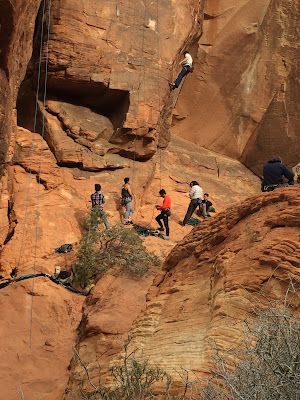I've had a lingering question about the "spike solution" phrase. What's the etymology of this?
For a long time, I thought of spike as in "nailing down some details."
Today, I found this: http://agiledictionary.com/209/spike/
I was wrong. I'm happy to see this explanation.
The phrase appears to come from spike (or piton) used in technical rock climbing. Strictly speaking, from "traditional" climbing with removable gear.
Since I started rock climbing about a year ago, I now have a deeper sense of what this "spike" thing really means.
Setting a spike makes safe progress possible. Once the spike is set, the climber has defined where the route is. A carabiner can be attached and the belay line placed there.
For people like me -- old and fat -- rock climbing is an indoor activity using a fixed "top-rope". The climbers call this "sport" climbing. There are tiers to this activity:
- Sport climbing is the most accessible level of climbing. Indoor sport climbing involves plastic holds bolted to a concrete wall. It's pretty easy. It's as much a problem-solving exercise as it is a physical exertion.
- Outdoor sport climbing involves fixed bolts. I've seen this from the ground. It looks like it might be fun.
- Traditional climbing involves removable gear like spikes, pitons, and cams. I've seen people training for this in indoor rock gyms. I've even belayed for folks doing a kind of hybrid training ascending a crack on top rope. This means no plastic holds -- just a crack in the concrete wall. I'm not sure I'll ever be able to do this.
- Alpine climbing, different from trail-head climbing. This is the kind of thing that may involve high altitudes, varied terrain, and long distances.
I don't have any direct experience with spikes, nor even placing carabiners on fixed bolts. I've seen some of this, though. I aspire to being able to do indoor "lead climbing". This is a common sport technique where the belay line is clipped to fixed bolts as the climber ascends. Someone who does lead climbing isn't relying on a previously set top rope.

For more information you'll need to look for the phrase "trad gear rack".
http://mojagear.com/learn/2014/05/16/building-a-trad-rack/
http://www.alpineinstitute.com/articles/expert-tips/how-to-select-an-alpine-rack/
As with software, there's a lot of jargon in rock climbing. "Pro" -- for example -- means protection. It's what you place to keep from getting hurt. A spike or a cam is a piece of pro.
I'm much happier using the term "spike solution" now that I see that my wintertime hobby fits with my day job.
And. Just to be complete, I need to point out that sailors use spikes all the time. For a sailor a spike is a tool used to untie (and tie) knots in line. See The Marlinspike Sailor for examples of what sailors do with line.
The problem with trying to find a sailing-related etymology is that (1) the term doesn't seem to be used, and (2) a sailor's "spike solution" would be a relatively permanently rigged arrangement of line. Sailors use the term "jury-rigged" to describe something temporary or experimental. The best part of marine terminology is that sailors speak their own language. Often there is no clear etymology to any other language.
Software folks, however, are masters of borrowing existing terms. "Spike" being an example of borrowing from technical rock climbing.